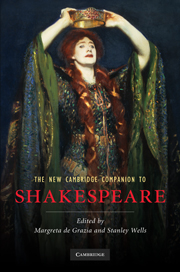Book contents
- Frontmatter
- 1 The traces of Shakespeare’s life
- 2 Shakespeare’s reading
- 3 Shakespeare’s writing: from manuscript to print
- 4 The theatre of Shakespeare’s London
- 5 The transmission of Shakespeare’s texts
- 6 Shakespeare and language
- 7 Shakespeare the poet
- 8 Shakespeare’s comedies
- 9 Shakespeare’s tragedies
- 10 Shakespeare’s English history plays
- 11 Shakespeare’s classical plays
- 12 Shakespeare’s tragicomedies
- 13 Shakespeare, religion and politics
- 14 Shakespeare and race
- 15 Shakespeare, sexuality and gender
- 16 Shakespeare on the stage
- 17 The critical reception of Shakespeare
- 18 Shakespeare and popular culture
- 19 Shakespeare and globalization
- 20 Shakespeare and media history
- 21 Shakespeare: reading on
- Index
14 - Shakespeare and race
Published online by Cambridge University Press: 28 January 2011
- Frontmatter
- 1 The traces of Shakespeare’s life
- 2 Shakespeare’s reading
- 3 Shakespeare’s writing: from manuscript to print
- 4 The theatre of Shakespeare’s London
- 5 The transmission of Shakespeare’s texts
- 6 Shakespeare and language
- 7 Shakespeare the poet
- 8 Shakespeare’s comedies
- 9 Shakespeare’s tragedies
- 10 Shakespeare’s English history plays
- 11 Shakespeare’s classical plays
- 12 Shakespeare’s tragicomedies
- 13 Shakespeare, religion and politics
- 14 Shakespeare and race
- 15 Shakespeare, sexuality and gender
- 16 Shakespeare on the stage
- 17 The critical reception of Shakespeare
- 18 Shakespeare and popular culture
- 19 Shakespeare and globalization
- 20 Shakespeare and media history
- 21 Shakespeare: reading on
- Index
Summary
Trying to understand race in Shakespeare's writing is an exercise fraught with difficulty. Even outside Shakespeare's work, the word race is a slippery one: its meaning can all too easily elude our grasp just when we think we know what it is. Take, for example, a Bollywood film called Race (2008). Set in South Africa, the film deals with a pair of brothers from that country's minority Indian community. Any prospective viewer aware of South Africa's history would expect the film's title to refer to themes of ethnic identity and racial tension. So we might be surprised to find that it refers instead to a tragic Cain-and-Abel struggle - the ongoing 'race' between the two brothers, waged first over horses and then with cars. This is an extreme example of race's slipperiness. But when used to denote racial identity, the term's meaning can be still harder to pin down. To some, race suggests biological differences based in physiognomy and skin colour. Skin colour, however, was not the ground of anti-Semitic racism in Nazi Germany. And recent years have seen the resurgence of an anti-Islamic racism that is again less about skin colour than about religious difference. Race is thus not a transparent concept but a bundle of contradictions. It is at one and the same time visible and invisible, a component of biological identity and a trope of cultural or religious difference. It is, in other words, a cluster of problems. This is just as much the case in Shakespeare’s writing, where race again poses profound problems of genealogy, colour and religion.
- Type
- Chapter
- Information
- The New Cambridge Companion to Shakespeare , pp. 201 - 216Publisher: Cambridge University PressPrint publication year: 2010
- 1
- Cited by



